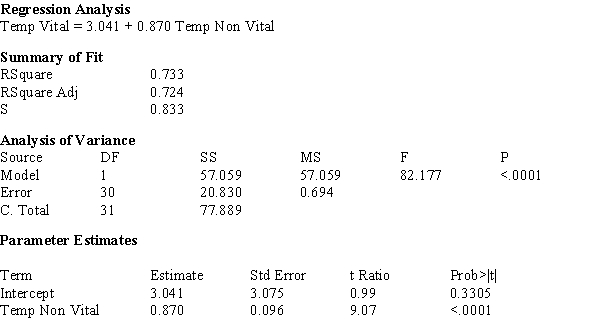In a study of the surface temperatures of vital (living) and non-vital (dead) teeth in a random sample of 32 adults seeking dental care at a university clinic, temperatures of vital and non-vital teeth were measured for each individual. The computer output shown below was generated. 
a) What proportion of observed variation in the surface temperature of vital teeth can be explained by the surface temperature of non-vital teeth?
b) Does the simple linear regression model appear to be useful? Justify your response with specific references to the computer output.
c) The estimated standard deviation of a + bx* for x* = 30 is calculated as: sa+b(30) = 0.2417. Calculate a 95% confidence interval for the true average vital tooth temperature when the non-vital tooth temperature is 30 degrees centigrade.
d) In one individual, a single surface temperature for a non-vital tooth is found to be 30 degrees centigrade. Use a 95% prediction interval to predict the resulting temperature of a vital tooth.
Definitions:
Reliable
The quality of being consistently good in performance, yielding trustworthy results over time.
Complete
fully finished or ended, with all necessary parts or elements present and accounted for.
Accurate
The degree to which a measurement, conclusion, or representation closely matches the true or correct value or outcome.
Computer Competency
The proficiency in using computer systems and software efficiently for a wide range of tasks.
Q5: One of the properties of Pearson's r
Q15: Jack invested $25,000 into an account paying
Q17: The model W = a + bL
Q20: The Iowa Tests of Educational Development are
Q25: A common practice of teachers is to
Q29: There is often a divergence between the
Q56: Last year Molex's net cash provided by
Q66: Choose the correct option below. <br>I. Macroeconomics
Q69: Maximization of shareholder wealth is not an
Q94: What information can be determined by common-size